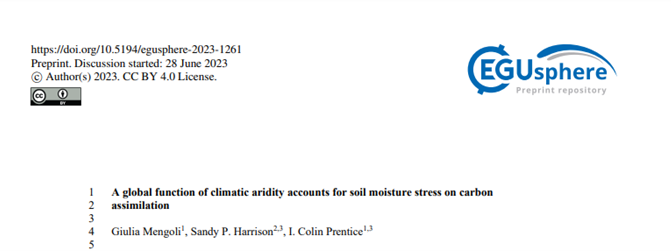Little pores on the leaf surface called stomata regulate the carbon intake and the water loss making these two tightly coupled. Plants assimilate carbon dioxide from the atmosphere to grow under changing conditions, such as light and temperature, and during this process they can lose water from the same pathway. Drought can affect this behaviour causing a stomatal closure in order to prevent water loss. As a consequence, plants reduce their carbon assimilation and grow less when water stress occurs.
Drought events are more and more frequent, happening also in places where there wasn’t such a problem before. Water limitation, specifically the amount of water in the soil (soil moisture), is an aspect that many models include in their schema to deal with the problem in getting overestimation of the model performance in dry environments. Most models use empirical soil moisture stress functions to constrain the models’ output and reduce their error in magnitude. The common use of these functions is to assume that there is a threshold, universally defined or plant-functional-type dependent, after which there is a reduction of the plant’s assimilation.
In this study the problem was approached in a slightly different way. It was firstly assumed that under well-watered conditions plants operate not at a maximum rate of assimilation, but they can operate at a lower rate. Secondly, the critical threshold is variable and can change across sites. And finally, the main driver for the critical threshold is the aridity.
Eddy covariance flux tower measurements were used to derive a new empirical function. A subset of 67 fluxnet sites covering a degree of aridity were analysed in this study investigating different years depending on data availability. 9 sites were classified as arid, 22 as semi-arid and 36 as humid.
A light-use efficiency model for plant productivity, the P model, was used in this study to obtain the model predictions, that is the gross primary production, GPP, at all 67 sites. Then the ratio between the observed GPP and the predicted well-watered GPP (beta theta ratio) was derived. Assuming that the P model is able to reproduce the diurnal cycle of GPP correctly in well-watered conditions (Mengoli et al. 2022) the ratio was thus used to compute the new function. A breaking point analysis, since the ratio was saturating in response to an increase of soil moisture, was conducted to derive the maximum level and the critical threshold of the beta theta ratio according to aridity levels. The relationship between the maximum level and the critical threshold was not linear so a non-linear regression analysis was used to devise the quantitative function to use to account for the soil moisture impact on GPP and thus reduce the overestimation in the P model performance.
The non parametric test confirmed that there are significant differences as we go from humid to arid sites in both the maximum level and the critical threshold: plants in humid environments have a higher maximum level than in semi-arid and arid places as well as the critical threshold. In other words, plants in arid places not only have adapted to operate at a lower rate than their maximum rate of assimilation/production but also, they keep this level for longer, as the critical threshold in arid sites is lower than in humid sites.
The application of the new soil moisture produces promising results improving the model performance both in unstressed and water-stressed conditions, compared to the version of the model where the soil moisture limitation was not accounted for and to an earlier version of the model in which another empirical function was used.
You can read the pre-print for the paper here: https://egusphere.copernicus.org/preprints/2023/egusphere-2023-1261/
Mengoli, G., Harrison, S. P., and Prentice, I. C.: A global function of climatic aridity accounts for soil moisture stress on carbon assimilation, EGUsphere [preprint], https://doi.org/10.5194/egusphere-2023-1261, 2023.

